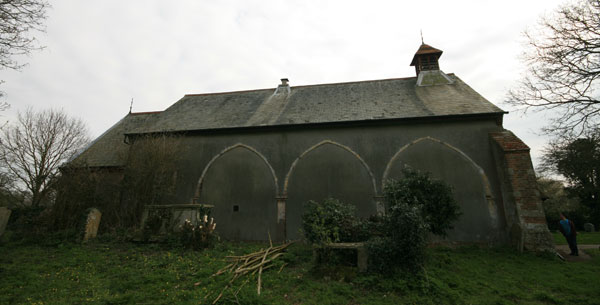
Ecclesiastical sleuths are not unknown to crime fiction and drama – there’s Father Dowling, there’s G K Chesterton’s Father Brown, and James Runcie’s Reverend Sidney Chambers.
But what about in real life? A priest has a pastoral duty to their flock, and who better than a priest to try to grasp the effects of good and evil. Members of the clergy inevitably find themselves on the cusp of crime. Whilst they might have to counsel family affected by violence, do they ever join forces with the police and help to solve mysteries?
In my research of nineteenth-century crime I’ve found two clergymen who found themselves drawn into investigations. In part 1, you’ll meet Reverend Wilkins from Wix in Essex, who suspected that one of his parishioners had met his death “by unfair means”. And in part 2, read about Reverend John Henry Cancellor, who found himself investigating the suspicious death of his own brother.

A somewhat eccentric clergyman
There was a lot of arsenic about the 1840s. Anyone could buy it, and it only cost a few pence from the grocer’s; you might use it as rat poison, or farmers might use it as a fungicide on livestock and seeds. It had many uses in industry, notoriously in green dye. It wouldn’t be until 1851 that shoppers would need to sign a register when purchasing it – this change partly came about thanks to the number of arsenic deaths which had taken place in the preceding decade, leading to pressure from scientists and press alike for arsenic’s control.
Reverend George Wilkins, a Gloucestershire man, was the parish priest of Wix, a village in north-east Essex, just outside Harwich. In 1848 he was in his late 50s, and had been the local vicar for over ten years. He had encountered Mary May some years earlier, when she had arrived in the village as a widow and soon – as he claimed – moved in with her boyfriend. The couple claimed they couldn’t afford to marry, so Wilkins later claimed that he had waived the fees and married them for free.
At the beginning of 1848, Mary’s half-brother William Constable – or Spratty Watts as he was also known – was arrested by Inspector Raison of the Essex Constabulary for stealing some metal from Wilkins. Constable was described as “a dealer in marine stores”. He went to the Petty Sessions and claimed that although the metal had been in his possession, he hadn’t known it was stolen, honest, guv’.
A few months later, Constable was dead. Wilkins added a note in the margin, “This man was better known by an alias, Spratty Watts.”
He was buried in a pauper’s grave, so imagine Rev Wilkins’ surprise when Mary, who Constable had lived with, arrived at the reverend’s door, saying that her brother had been in a burial club, and they wouldn’t pay out.
Burial clubs were established as a way for the poor to ensure a decent burial for their loved ones. A small amount of money paid into a club each week would hopefully provide around £10 – about half an agricultural labourer’s annual wage in the late 1840s – for a burial. The other option was for a pauper’s burial, paid for by the parish. Since the 1832 Anatomy Act, designed to curb graverobbers and Burkers, any corpse destined for a pauper’s grave could end up in a medical school dissection room. The burial club was a cheap and convenient way to avoid being anatomised, something which certain Christians believed would prevent them from rising whole from the grave on Judgement Day.
Add cheap and easily available poison to a large payout from a burial club, and you have means and motive for a murder.
Reverent Wilkins was even more surprised when he found out that Constable had died only one month after being entered into a burial club. Mary said that the club thought she had lied on entering her brother – that he was already ill, which went against their rules. All Mary wanted from the good reverend was a signed piece of paper declaring that Constable had been in good health.
But if he had been in good health, he had died rather quickly. Not that such a thing was unusual in the 1840s, when “English cholera” – a catch-all for violent upset stomachs – took lives and otherwise made people rather ill. Alas that the symptoms of English cholera and arsenic poisoning were so similar.
Reverend Wilkins told Mary in no uncertain terms that if anyone should have the burial club money, it should be the parish, because they’d paid for her brother’s burial. Mary was insistent that it was hers, and Wilkins reminded her that it would in fact be her husband’s – reflecting the situation of women and their property at the time.
“He’s got a son,” Mary said, implying that the money could go to him.
“He’s illegitimate and cannot inherit it,” Wilkins declared; illegitimate children could not automatically inherit anything. He repeated that the money would go to Mary’s husband, but then she revealed her secret.
“My husband knows nothing about it – I put him in the burial club myself.”
This piqued Rev Wilkins’ suspicions, so he went to Inspector Raison. Was there a murderer at large in his parish?
Raison went to visit Mary May. Under the guise of helping her to get her burial club money, Mary told him about her brother’s illness and her frustration at not being able to get at the money. When Mary said she’d fetch her neighbour to back her up, Raison said he would himself, “and then the club will think there’s no smuggling in it.”
It is rather lovely that “smuggling” was used as a slang term for underhand behaviour on a coastline that was riddled with “freetraders”.
Raison was just as a suspicious as Rev Wilkins by this point, so the two men – Inspector and Reverend – went off to Harwich to meet the men behind the burial club.
Very soon Mary May was arrested, William Constable was exhumed, and Alfred Swaine Taylor was sent his viscera to analyse. The eminent professor found arsenic and declared that it had killed Constable. Wilkins added a further note in the margin of his burial register – “He was poisoned with arsenic…” and the rest of the note will give away what happens in Poison Panic, so for the benefit of those of you who haven’t read it yet, I will cut away to a few years later….
…when Wilkins, for his involvement in the case of Constable’s death, received poison-pen letters. And got drunk at a farmers’ dinner where he was quoted in the local press when he made a toast to fox hunting and said that “if they had more amusement and less preaching they should be a much happier and more moral people.” Alas, his words were picked up and printed by newspapers further afield, and questions were raised about members of the Anglican clergy behaving in a way that makes the Bishop of Southwark sound like a teetotaler.
And, on the day of public thanksgiving following the end of the Crimean War, Wilkins earned himself more column inches by standing in the pulpit and “commenting upon what he considered had been the immoral conduct of one of his parishioners.” The man in question, a farmer called James Eagle took great umbrage at being subjected to such comments. He rose from his pew, “and in profane language accused Mr Wilkins of falsehood.”
Rather than make a dignified exit, the crime-busting clergyman “rejoined in the most coarse and vehement manner; and an altercation ensued between them of a character which would disgrace the lowest public house.” The service ended early as other worshippers left the church in disgust, and Wilkins was investigated by the diocesan bishop at Colchester Castle.
Oh dear.
But the bishop, although issuing Wilkins with a reprimand, at least realised that his priest had been through difficult times. He acknowledged that there were people in Wix “who entertain malicious feelings towards you – very unjustly as I have reason to believe.”
Wilkins was interested in agriculture, writing many letters over the years to newspapers and journals alike about farming matters. In the late 1840s, even while involving himself in the arsenic mysteries that haunted Essex at the time, he was investigating the spread of potato blight in south-east England.
It is little wonder that, when Reverend Wilkins died 1877, having served as Wix’s parish priest for forty years, he was remembered in an obituary as a “somewhat eccentric clergyman.”
Based on material in Poison Panic.